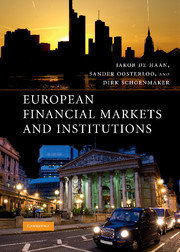Book contents
- Frontmatter
- Contents
- List of Boxes
- List of Figures
- List of Tables
- List of Countries
- List of Abbreviations
- Preface
- Part I Setting the Stage
- Part II Financial Markets
- Part III Financial Institutions
- 6 The Role of Institutional Investors
- 7 European Banks
- 8 The Financial System of the New Member States
- 9 European Insurers and Financial Conglomerates
- Part IV Policies for the Financial Sector
- Index
- References
9 - European Insurers and Financial Conglomerates
from Part III - Financial Institutions
- Frontmatter
- Contents
- List of Boxes
- List of Figures
- List of Tables
- List of Countries
- List of Abbreviations
- Preface
- Part I Setting the Stage
- Part II Financial Markets
- Part III Financial Institutions
- 6 The Role of Institutional Investors
- 7 European Banks
- 8 The Financial System of the New Member States
- 9 European Insurers and Financial Conglomerates
- Part IV Policies for the Financial Sector
- Index
- References
Summary
OVERVIEW
The function of insurance is to protect individuals and firms from adverse events through the pooling of risks. Life insurance protects against premature death, disability, and retirement. Non-life insurance protects against risks such as accidents, illness, theft, and fire. Insurance is a risky business, as insurance companies collect premiums and provide cover for adverse events that may or may not arise somewhere in the future. The pattern of small claims, such as fire or car accidents, is fairly predictable. However, larger accidents or catastrophes (like hurricanes) involve high claims with low probability.
The insurance business is plagued by asymmetric information problems. There is a moral hazard problem when the behaviour of the insured, which can be only partly observed by the insurer, may increase the likelihood that the insurer has to pay. After signing the contract, the insured may behave less cautiously because of the insurance. Another problem is adverse selection. High-risk individuals (for instance, ill people) may seek out more (health) insurance than low-risk persons. The insurer may therefore end up with a pool of relatively high risks. Mechanisms to separate high from low risks are explained in this chapter.
Insurance companies tend to centralise risk management, using internal risk-management models at their headquarters. But there is still a role for local business units to capture factors that are location-specific. The same is true for asset management. As insurance companies are large asset managers, they can profit from economies of scale through the pooling of assets.
- Type
- Chapter
- Information
- European Financial Markets and Institutions , pp. 259 - 296Publisher: Cambridge University PressPrint publication year: 2009

